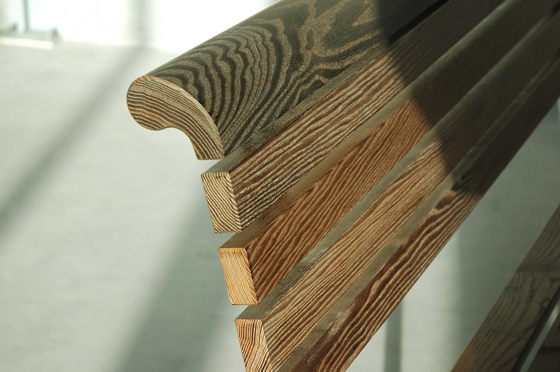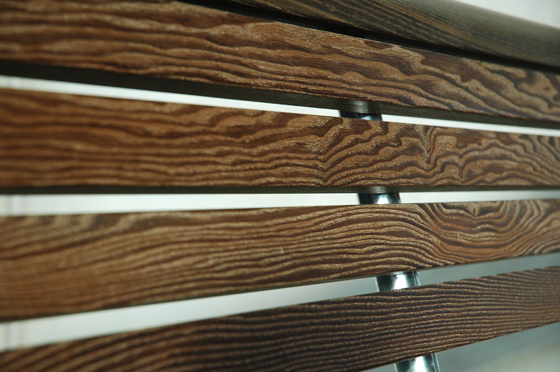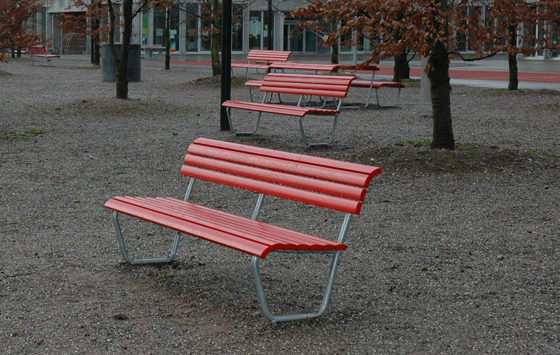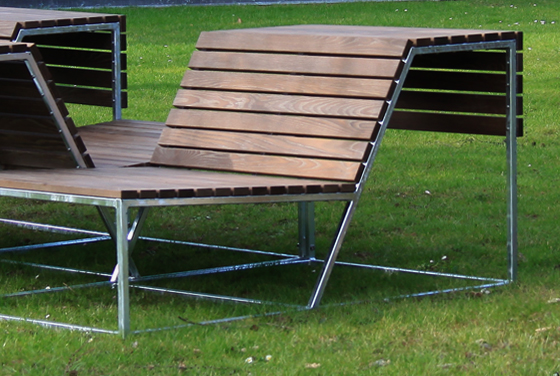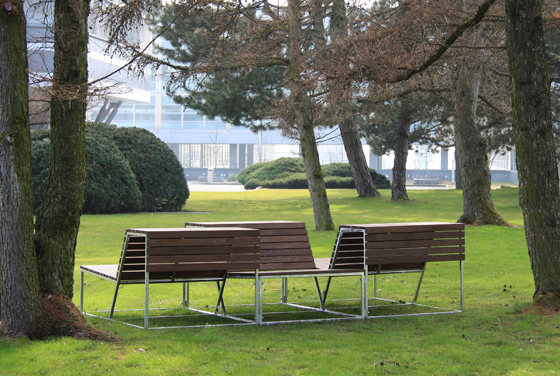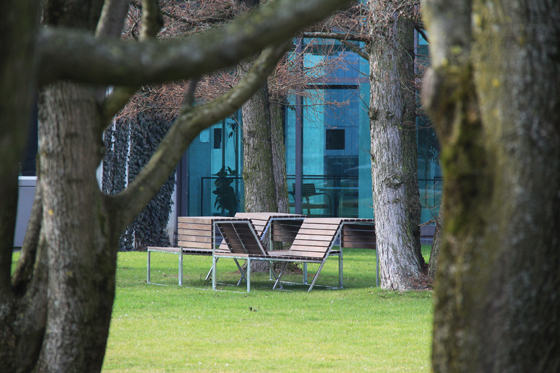Upgrading Nature: a Revolutionary Treatment for Wood in Outdoor Areas
Text by BURRI
Glattbrugg, Switzerland
09.03.12
Wood in the Public Space – an Exciting Challenge: we identify a city based on its buildings, its landscape architecture, and its density – however, it is above all the city furniture that makes a cityscape unique and distinctive.
Classic design, new material: Landi bench by Burri materialised in Natwood
City furniture must have a timeless design, be extremely resistant, and above all must stay beautiful for a long time at minimum maintenance. The life cycle costs of a city infrastructure are an important factor for investment decisions. With wood especially, there may be long-term problems caused by standing water or moss which damages the surface and adversely affects aesthetics, safety and user comfort. This means that life cycle costs could be significantly reduced if these weaknesses could be eliminated without a coating while at the same time substantially increasing durability.
One such alternative is tropical timber; however, given the long transportation distances, it has a bad ecological footprint. Also, even despite increasing certification, it is not always clear if the wood was legally harvested, due to widespread corruption. For these reasons, BURRI decided as long as 20 years ago to do without tropical timber and switched to domestic untreated larch. As BURRI constantly strives to further improve product lifetime, they are constantly looking for new innovative materials.
Initially thermally modified timber seemed to be the solution, but in view of its unfavourable properties it is a bad compromise. Cracking and splintering occur, especially at the edges which also compromises the safety of users. Due to its brittleness its tensile strength for screws is also inferior.
NATWOOD – Wood 2.0
After searching and testing extensively, BURRI public elements finally found a strong partner in tilo GmbH, a medium-sized company in Austria that has developed an innovative environmentally friendly refining procedure. The specially refined wood, called NATWOOD, surpasses the durability and sturdiness of thermally modified timber and tropical timber. Domestic fir and ash are refined with natural materials in such a way that the wood lasts over 25 years without additional maintenance. This is equivalent to durability class 1 pursuant to test standard CEN/TS 15083-1 whereas plantation teak at best has durability class 3 (up to 15 years). The material wood, too, has finally arrived in the 21st century.
As a leading provider of infrastructure for the Swiss cityscape, BURRI public elements has recognized the enormous potential of the new procedure and has obtained the exclusive distribution rights for outdoor furniture treated with this procedure.
The classical red Landi bench, designed by Alfred Altherr & Charles Hoch 1939
The Innovative Refining Procedure for Domestic Timber
The improved material properties of this natural wood that is cut directly from the trunk, i.e. is not a compressed wood product, are a result of the revolutionary procedure:
After thermal treatment, natural tree resins and waxes are pressed into the wood cells and cell walls in a pressure chamber at elevated temperatures. Thanks to a highly sophisticated cooling process, the resin in the wood solidifies, similar to the formation of amber.
The shrinkage and swelling conduct is reduced and the wood obtains a high degree of dimension and shape stability, i.e. it does not "work" as much.
Landscape benches designed by Frederic Dedelley for Burri in Natwood, ETH Campus Science City
Tested in the "di-sta" Wood Study Conducted by the isp Research Center of the Technical University Rosenheim
In wood processing, the tensile strength of NATWOOD pine is up to 25% and 40% better than that of untreated pine, depending on the type of screw used. The compression strength parallel to the fibre is increased by 80%; as a result hardly any splintering and indentations occur. The impact strength of NATWOOD is 10% better than that of untreated wood, whereas that of thermally modified timber is reduced by 60%. The most obvious benefit lies in the Brinell hardness which could be increased by 200%. This and the modulus of elasticity of NATWOOD which is improved by 40% enable a significantly longer life cycle of timber products even under heavy use.
Landscape bench designed by Frederic Dedelley for Burri in Natwood, ETH Campus Science City
Proven in Practice
In NATWOOD which can be won from ash, fir and pine, the optically appealing wood structure is emphasized even more by loading the wood with natural resins and waxes. At the same time, the penetration of dirt and moisture as well as moss problems and insect infestations are largely prevented as the surface remains smooth and sealed for a long time, also when exposed to weather and even to significant fluctuations in temperature and humidity.
This makes NATWOOD an interesting material for furniture designers. They especially value the enhancement of the wood grain also after weathering as the use of macerated wood so far was impossible in outdoor areas due to its sensitivity to weather conditions.
Considering the maintenance costs, the potential savings compared to conventional timber are enormous; for this reason existing objects, too, are increasingly upgraded to NATWOOD.
The well-known Swiss designer Frédéric Dedelley, for example, designed for BURRI the LANDSCAPE Bench for the MFO Park. Now a NATWOOD version of this design is presented on the Campus of ETH Science City. The Landi bench for senior citizens shows an additional benefit of the smooth surface structure of NATWOOD: it allows easy sliding when sitting down and getting up. In addition, the sitting surface dries quickly after precipitation as hardly any water can penetrate.
Landscape bench designed by Frederic Dedelley for Burri in Natwood
A Sustainable Investment
Thanks to the complete elimination of chemicals or artificial wood impregnations that are difficult to dispose of, NATWOOD leaves a very small ecological footprint, also due to the exclusive use of domestic timber from Central Europe.
Compared to tropical timber, it not only has a longer life cycle, but also is more economical to purchase.
As a renewable raw material, timber also is a climate-friendly CO2 store. However, this CO2 balance will be positive only if transportation distances are minimized. The European forests can only be conserved and managed sustainably if there is an economically viable use of this wood. For this reason, customers in the public space, who are increasingly interested in sustainable solutions, especially appreciate NATWOOD.



